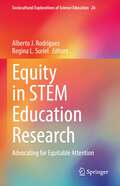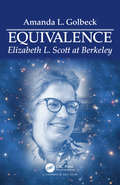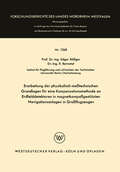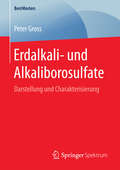- Table View
- List View
Equine Genomics
by Bhanu P. ChowdharyAnalysis of the equine genome began just over a decade ago, culminating in the recent complete sequencing of the horse genome. The availability of the equine whole genome sequence represents the successful completion of an important era of equine genome analysis, and the beginning of a new era where the sequence information will catalyze the development of new tools and resources that will permit study of a range of traits that are economically important and are significant to equine health and welfare. Equine Genomics provides a timely comprehensive overview of equine genomic research. Chapters detail key accomplishments and the current state of research, as well as looking forward to possible applications of genomic technologies to horse breeding, health, and welfare. Equine Genomics delivers a global overview of the topic and is seamlessly edited by a leading equine genomics researcher. Equine Genomics is an indispensible source of information for anyone with an interest in this increasingly important field of study, including equine genomic researchers, clinicians, animal science professionals and equine field veterinarians.
Equipment for Diagnostic Radiography
by E. ForsterI hope this book, which covers the Equipment section of With the help of the Superintendent find out which quality the DCR and HDCR syllabuses, will be of help not only assurance tests are carried out on the equipment and ask to those students preparing for these examinations, but for permission to participate in the procedures. also for those taking the modular HDCR to be introduced Remember, radiography is a practical subject - learning sometime in the near future, and indeed to those returning from books is of little value unless you apply it to the to radiography after a break in service. work you are doing - unless of course you are preparing In addition to reading a wide range of technical litera for a change of job or promotion! ture, I would hope that students will relate this knowledge Finally, whether you are using this book to refresh your to the equipment they use in the Department. For example knowledge prior to returning to radiography after a break what type of equipment are they using? Who was the in service, or as part of your preparation for the DCR or manufacturer? What sort of generator is it? What inter HDCR, or indeed if you are using it in conjunction with locks are present? What is the maximum loading of the a distanced learning course, may I wish you good luck and tube? Is it a falling load generator? success in your endeavours.
Equity and Science Education Reform
by Sharon J. LynchThis lucid, accessible, thought-provoking discussion of issues related to equity in science education reform is for science educators, including idealists and exacting pragmatists, who are dedicated to exploring what it means to put into practice rallying cries like "science literacy for all," "equity and excellence," and "standards-based reform." Intended as an enjoyable and stimulating read, as opposed to a comprehensive summary of everything ever written about equity in science education, it is a response to the new science education standards and reforms, with their goal of science literacy for all. If this goal is to be taken seriously, the implications are immense. A central purpose of this book is to project and discuss how achieving this goal would affect science education reform and vice versa. The work is research based, using statistics, tables, and figures drawn primarily from NSF reports and other public information documents to provide a foundation for equity concerns. However, these statistics are not the main focus of the book. Rather, they are used to make a case, backed by pertinent research, the literature on best practice, and provocative examples from schools and classrooms. Charts, tables, and graphic organizers provide visual evidence and enhance the arguments presented. Moving from research-based studies to classroom stories, Equity and Science Education Reform encourages readers to think about the complexity of the issues. No easy answers or quick fixes are offered. Researching across "identity" areas and attempting to unite them in a discussion that recognizes both the common elements as well as important distinctions, it provides a comprehensive picture of equity concerns across ethnicity, class, gender, and location. Encompassing a broad literature in science education, reform and policy, and equity issues, it offers an "equity schema" as a unifying concept to guide discussion throughout. This book is based, in part, on a series of nine background papers that were commissioned by the American Association for the Advancement of Science's Project 2061 and the summary document, which was written by the author of this book. But it goes far beyond the original study to provide a consistent, coherent, and lively discussion that vividly illustrates the issues raised by the experiences of teachers and students who are struggling with equity principles in the context of science education reform.
Equity and Science Education Reform
by Sharon J. LynchThis lucid, accessible, thought-provoking discussion of issues related to equity in science education reform is for science educators, including idealists and exacting pragmatists, who are dedicated to exploring what it means to put into practice rallying cries like "science literacy for all," "equity and excellence," and "standards-based reform." Intended as an enjoyable and stimulating read, as opposed to a comprehensive summary of everything ever written about equity in science education, it is a response to the new science education standards and reforms, with their goal of science literacy for all. If this goal is to be taken seriously, the implications are immense. A central purpose of this book is to project and discuss how achieving this goal would affect science education reform and vice versa. The work is research based, using statistics, tables, and figures drawn primarily from NSF reports and other public information documents to provide a foundation for equity concerns. However, these statistics are not the main focus of the book. Rather, they are used to make a case, backed by pertinent research, the literature on best practice, and provocative examples from schools and classrooms. Charts, tables, and graphic organizers provide visual evidence and enhance the arguments presented. Moving from research-based studies to classroom stories, Equity and Science Education Reform encourages readers to think about the complexity of the issues. No easy answers or quick fixes are offered. Researching across "identity" areas and attempting to unite them in a discussion that recognizes both the common elements as well as important distinctions, it provides a comprehensive picture of equity concerns across ethnicity, class, gender, and location. Encompassing a broad literature in science education, reform and policy, and equity issues, it offers an "equity schema" as a unifying concept to guide discussion throughout. This book is based, in part, on a series of nine background papers that were commissioned by the American Association for the Advancement of Science's Project 2061 and the summary document, which was written by the author of this book. But it goes far beyond the original study to provide a consistent, coherent, and lively discussion that vividly illustrates the issues raised by the experiences of teachers and students who are struggling with equity principles in the context of science education reform.
Equity and Sustainability (Approaches to Global Sustainability, Markets, and Governance)
by David Crowther Shahla SeifiThis book delves into the multifaceted concept of sustainability, placing a particular emphasis on the social dimension and its intersection with economic and environmental considerations. It examines how individuals, corporations, and institutions can adapt their behaviors to align with sustainable practices. Through a global perspective, the book explores various aspects of behavior changes required for sustainability, highlighting diverse approaches adopted in different regions around the world. One of the central themes explored in this book is the notion of equity in sustainability. While it is acknowledged that complete equality is unattainable, the book argues that achieving fairness in outcomes is essential for the stability and longevity of sustainable practices. Without equity, there is a risk of social unrest and instability, which could undermine the sustainability agenda. Drawing on contributions from scholars representing diverse international backgrounds, the book offers fresh perspectives and innovative solutions to the challenges of sustainability. Rooted in the tradition of the Social Responsibility Research Network (SRRNet), this book embodies the network's ethos of promoting dialogue, sharing best practices, and seeking relevant solutions. It aims to inspire new thinking and action toward a more sustainable and equitable future for all, presenting a blend of academic rigor and practical insights. Through its exploration of sustainability from a social perspective, this book contributes to the ongoing discourse on how to address the pressing global challenges of our time.
Equity for Women in Science: Dismantling Systemic Barriers to Advancement
by Cassidy R. Sugimoto Vincent LarivièreThe first large-scale empirical analysis of the gender gap in science, showing how the structure of scientific labor and rewards—publications, citations, funding—systematically obstructs women’s career advancement.If current trends continue, women and men will be equally represented in the field of biology in 2069. In physics, math, and engineering, women should not expect to reach parity for more than a century. The gender gap in science and technology is narrowing, but at a decidedly unimpressive pace. And even if parity is achievable, what about equity?Equity for Women in Science, the first large-scale empirical analysis of the global gender gap in science, provides strong evidence that the structures of scientific production and reward impede women’s career advancement. To make their case, Cassidy R. Sugimoto and Vincent Larivière have conducted scientometric analyses using millions of published papers across disciplines. The data show that women are systematically denied the chief currencies of scientific credit: publications and citations. The rising tide of collaboration only exacerbates disparities, with women unlikely to land coveted leadership positions or gain access to global networks. The findings are unequivocal: when published, men are positioned as key contributors and women are relegated to low-visibility technical roles. The intersecting disparities in labor, reward, and resources contribute to cumulative disadvantages for the advancement of women in science.Alongside their eye-opening analyses, Sugimoto and Larivière offer solutions. The data themselves point the way, showing where existing institutions fall short. A fair and equitable research ecosystem is possible, but the scientific community must first disrupt its own pervasive patterns of gatekeeping.
Equity in STEM Education Research: Advocating for Equitable Attention (Sociocultural Explorations of Science Education #26)
by Alberto J. Rodriguez Regina L. SurielThis book focuses on the creative and transformative work of scholars who are advancing social justice through science/STEM education with limited resources. It draws attention to the significant body of work being conducted in various contexts so that readers could reflect and appreciate how much broader and transformative our impact could be if funding agencies, policy makers, and other researchers would widen their perspective and seek to promote social justice-driven scholarship. Public funding for STEM research on K-12 and teacher education that targets special populations is often limited and tends to favor mainstream research. This book contains case studies on innovative and promising STEM research with a focus on equity, diversity and social justice that are funded with limited or no public funding. It also presents anecdotes from authors in relation to their struggles in either securing funding for their reported study or seeking to publish its findings. This provides more context to the challenges of conducting non-mainstream research in science/STEM education. Most of the contributors are scholars of color and/or women conducting research with traditionally marginalized populations in science/STEM. Thus, this book offers an additional venue to share the voices of marginalized scholars and allies seeking to broaden our understanding of the challenges and successes of promoting equity, diversity, and social justice in various educational contexts.
Equivalence: Elizabeth L. Scott at Berkeley
by Amanda L. GolbeckEquivalence: Elizabeth L. Scott at Berkeley is the compelling story of one pioneering statistician’s relentless twenty-year effort to promote the status of women in academe and science. Part biography and part microhistory, the book provides the context and background to understand Scott’s masterfulness at using statistics to help solve societal problems. In addition to being one of the first researchers to work at the interface of astronomy and statistics and an early practitioner of statistics using high-speed computers, Scott worked on an impressively broad range of questions in science, from whether cloud seeding actually works to whether ozone depletion causes skin cancer. Later in her career, Scott became swept up in the academic women’s movement. She used her well-developed scientific research skills together with the advocacy skills she had honed, in such activities as raising funds for Martin Luther King Jr. and keeping Free Speech Movement students out of jail, toward policy making that would improve the condition of the academic workforce for women. The book invites the reader into Scott’s universe, a window of inspiration made possible by the fact that she saved and dated every piece of paper that came across her desk.
Equivalence: Elizabeth L. Scott at Berkeley
by Amanda L. GolbeckEquivalence: Elizabeth L. Scott at Berkeley is the compelling story of one pioneering statistician’s relentless twenty-year effort to promote the status of women in academe and science. Part biography and part microhistory, the book provides the context and background to understand Scott’s masterfulness at using statistics to help solve societal problems. In addition to being one of the first researchers to work at the interface of astronomy and statistics and an early practitioner of statistics using high-speed computers, Scott worked on an impressively broad range of questions in science, from whether cloud seeding actually works to whether ozone depletion causes skin cancer. Later in her career, Scott became swept up in the academic women’s movement. She used her well-developed scientific research skills together with the advocacy skills she had honed, in such activities as raising funds for Martin Luther King Jr. and keeping Free Speech Movement students out of jail, toward policy making that would improve the condition of the academic workforce for women. The book invites the reader into Scott’s universe, a window of inspiration made possible by the fact that she saved and dated every piece of paper that came across her desk.
Equivalency Methods for Environmental Liability: Assessing Damage and Compensation Under the European Environmental Liability Directive
by Joshua Lipton Ece Özdemiroğlu David Chapman Jennifer PeersThe book is the only technical volume that explains how equivalency analysis methods mentioned in Annex II of the European Environmental Liability Directive should be implemented. It uses case studies to illustrate real-world application of the methods, which are based on the experience in the USA and in the European Union and have been tested in three years of training programs funded by the European Commission. Academically rigorous and technically comprehensive, the book is intended for technical experts wanting to assess damage and remediation options as well as for decision-makers wishing to commission such assessments and judge their quality. These include competent authorities, operators, financial security providers, academics, consultants and NGOs.
Equivalent-Small-Parameter Analysis of DC/DC Switched-Mode Converter (CPSS Power Electronics Series)
by Yanfeng Chen Bo ZhangThis book focuses on the applications of Equivalent-Small-Parameter Method (ESPM) in solving the steady-state periodic solutions, as well as stability analysis, of kinds of open-loop or closed-loop operated DC/DC converters, such as PWM, quasi-resonant and resonant ones. The analytical expressions of DC components and harmonics of state variables (inductor current and capacitor voltage) with DC/DC converters can be obtained by ESPM, which can be helpful to understand the nonlinear operating mechanism of switched-mode converters. It can also be useful for stability analysis and design for practical converters. Modeling and analysis on all kinds of DC/DC converters are introduced in detail in this book, along with a large amount of simulation or experimental waveforms to verify the correctness of the theoretical analysis based on ESPM.
Equivariant Cohomology and Localization of Path Integrals (Lecture Notes in Physics Monographs #63)
by Richard J. SzaboThis book, addressing both researchers and graduate students, reviews equivariant localization techniques for the evaluation of Feynman path integrals. The author gives the relevant mathematical background in some detail, showing at the same time how localization ideas are related to classical integrability. The text explores the symmetries inherent in localizable models for assessing the applicability of localization formulae. Various applications from physics and mathematics are presented.
Equivocal Child Abuse
by Sandra B. McPherson Farshid AfsarifardChild abuse cases with hard-to-prove allegations pose challenges for all those who seek to protect the welfare of children. Helping courts, evaluators, guardians, and lawyers understand and work with difficult cases, Equivocal Child Abuse brings together insights, experience, and guidance from multiple sources to minimize unnecessary harm done to c
Erarbeitung der physikalisch-meßtechnischen Grundlagen für eine Kompensationsmethode an Erdfelddetektoren in magnetkompaßgestützten Navigationsanlagen in Großflugzeugen (Forschungsberichte des Landes Nordrhein-Westfalen #1268)
by Edgar RößgerErarbeitung physikalischer Größen und Gesetze im Physikunterricht der Sekundarstufe I unter Einsatz von Schülerexperimenten (Forschungsberichte des Landes Nordrhein-Westfalen #3132)
by Manfred BormannErase the Waste and Turn Trash Into Cash: Inquiry-Based Science Lessons for Advanced and Gifted Students in Grades 3-4
by Jason S. McIntoshRecipient of the 2021 NAGC Curriculum Award Americans throw away 254 million tons of trash every year, and students are naturally curious about where it all goes. Erase the Waste and Turn Trash Into Cash, a 30-lesson interdisciplinary science unit: Is designed to teach high-ability third and fourth graders how to think like real-world environmental engineers. Requires students to reduce, reuse, recycle, and reimagine trash in new and innovative ways. Was designed using the research-based Integrated Curriculum Model. Features challenging problem-based learning tasks and engaging resources. Includes detailed teacher instructions and suggestions for differentiation. In this unit, students study the concept of innovation and learn to manage and dispose of waste in creative and environmentally friendly ways, all while building an understanding of sustainability, recycling, environmental science, and the green economy. Suggestions and guidance are included on how teachers can adjust the rigor of learning tasks based on students' interests and needs. Grades 3-4
Erase the Waste and Turn Trash Into Cash: Inquiry-Based Science Lessons for Advanced and Gifted Students in Grades 3-4
by Jason S. McIntoshRecipient of the 2021 NAGC Curriculum Award Americans throw away 254 million tons of trash every year, and students are naturally curious about where it all goes. Erase the Waste and Turn Trash Into Cash, a 30-lesson interdisciplinary science unit: Is designed to teach high-ability third and fourth graders how to think like real-world environmental engineers. Requires students to reduce, reuse, recycle, and reimagine trash in new and innovative ways. Was designed using the research-based Integrated Curriculum Model. Features challenging problem-based learning tasks and engaging resources. Includes detailed teacher instructions and suggestions for differentiation. In this unit, students study the concept of innovation and learn to manage and dispose of waste in creative and environmentally friendly ways, all while building an understanding of sustainability, recycling, environmental science, and the green economy. Suggestions and guidance are included on how teachers can adjust the rigor of learning tasks based on students' interests and needs. Grades 3-4
Eratosthenes' "Geography"
by Eratosthenes Duane W. RollerThis is the first modern edition and first English translation of one of the earliest and most important works in the history of geography, the third-century Geographika of Eratosthenes. In this work, which for the first time described the geography of the entire inhabited world as it was then known, Eratosthenes of Kyrene (ca. 285-205 BC) invented the discipline of geography as we understand it. A polymath who served as librarian at Alexandria and tutor to the future King Ptolemy IV, Eratosthenes created the terminology of geography, probably including the word geographia itself. Building on his previous work, in which he determined the size and shape of the earth, Eratosthenes in the Geographika created a grid of parallels and meridians that linked together every place in the world: for the first time one could figure out the relationship and distance between remote localities, such as northwest Africa and the Caspian Sea. The Geographika also identified some four hundred places, more than ever before, from Thoule (probably Iceland) to Taprobane (Sri Lanka), and from well down the coast of Africa to Central Asia. This is the first collation of the more than 150 fragments of the Geographika in more than a century. Each fragment is accompanied by an English translation, a summary, and commentary. Duane W. Roller provides a rich background, including a history of the text and its reception, a biography of Eratosthenes, and a comprehensive account of ancient Greek geographical thought and of Eratosthenes' pioneering contribution to it. This edition also includes maps that show all of the known places named in the Geographika, appendixes, a bibliography, and indexes.
ErbB Receptor Signaling: Methods and Protocols (Methods in Molecular Biology #1652)
by Zhixiang WangThis volume contains protocols specifically designed for studying cell signaling mediated by ErbB receptors, all applicable to the study of a broad range of ErbB receptor-mediated signaling from basic research to clinic applications, from cultured cells to various animal models and primary cancer cells from patients. After some overviews, the book continues by covering common protocols for studying various aspects of ErbB receptor-mediated cell signaling, newly-developed methods in biomedical research that are also widely-used in the study of ErbB receptor signaling, epidermal growth factor receptor (EGFR) signaling in Drosophila, as well as protocols for studying ErbB receptor signaling in various animal model systems. Written in the highly successful Methods in Molecular Biology series format, chapters include introductions to their respective topics, lists of the necessary materials and reagents, step-by-step, readily reproducible laboratory protocols, and tips on troubleshooting and avoiding known pitfalls. Detailed and easy-to-follow, ErbB Receptor Signaling: Methods and Protocols serves as an ideal guide for researchers who are studying the cell signaling mediated by ErbB receptors and other receptor tyrosine kinases.
Erblichkeitsuntersuchungen an Nigella Damascena L.
by Hendrik Jannes ToxopéusDieser Buchtitel ist Teil des Digitalisierungsprojekts Springer Book Archives mit Publikationen, die seit den Anfängen des Verlags von 1842 erschienen sind. Der Verlag stellt mit diesem Archiv Quellen für die historische wie auch die disziplingeschichtliche Forschung zur Verfügung, die jeweils im historischen Kontext betrachtet werden müssen. Dieser Titel erschien in der Zeit vor 1945 und wird daher in seiner zeittypischen politisch-ideologischen Ausrichtung vom Verlag nicht beworben.
Erdalkali- und Alkaliborosulfate: Darstellung und Charakterisierung (BestMasters)
by Peter GrossPeter Gross stellt die Synthesen und Kristallzucht der ersten teils protonierten Alkalimetall-Borosulfate sowie Erdalkalimetall-Borosulfate beispielhaft für Kalium- und Bariumverbindungen vor. Er erläutert praktische Aspekte der anspruchsvollen Probenpräparation, Strukturaufklärung und Bestimmung der Reinheit. Der Autor diskutiert anschließend die Ergebnisse, systematisiert und ordnet die Verbindungen in die Systematik silicatanaloger Verbindungen ein, um die einzigartige Stellung dieser neuen Materialklasse zu illustrieren. Eine Machbarkeitsstudie zeigt als eine der vielfältigen Anwendungsfelder den Einsatz von Borosulfaten als Wirtsstruktur für Leuchtstoffe.
Erdalkalimetalle: Eine Reise durch das Periodensystem (essentials)
by Hermann SiciusHermann Sicius stellt die Elemente der zweiten Hauptgruppe des Periodensystems, die Erdalkalimetalle, mit ihren wichtigsten Eigenschaften und Anwendungsgebieten vor. Die Elemente dieser Gruppe – Beryllium, Magnesium, Calcium, Strontium, Barium und Radium – sind zwar sämtlich Metalle, zeigen aber deutliche Abstufungen ihrer Charakteristika und überraschende Eigenheiten: Beryllium ist durchlässig für Röntgenstrahlen und Barium aus derselben Gruppe nicht; Beryllium- und Bariumverbindungen sind sehr giftig, Calcium- und Magnesiumverbindungen für uns dagegen lebensnotwendig. In diesem Essential erfahren Sie alles Wichtige über diese interessante Hauptgruppe.






















